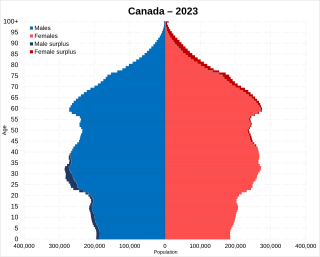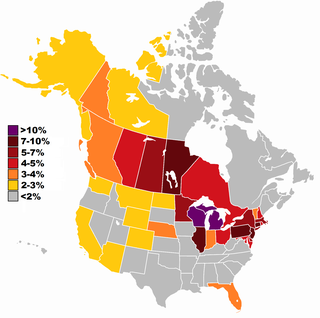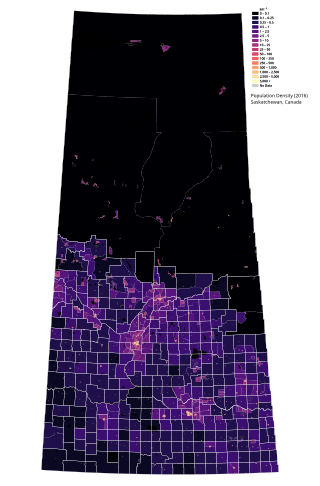
Statistics Canada conducts a country-wide census that collects demographic data every five years on the first and sixth year of each decade. The 2021 Canadian census enumerated a total population of 36,991,981, an increase of around 5.2 percent over the 2016 figure, Between 2011 and May 2016, Canada's population grew by 1.7 million people, with immigrants accounting for two-thirds of the increase. Between 1990 and 2008, the population increased by 5.6 million, equivalent to 20.4 percent overall growth. The main driver of population growth is immigration, and to a lesser extent, natural growth.

South Asian Canadians are Canadians who were either born in or can trace their ancestry to the Indian subcontinent, which includes the nations of India, Pakistan, Bangladesh, Nepal, Sri Lanka, Bhutan, and the Maldives.

Polish Canadians are citizens of Canada with Polish ancestry, and Poles who immigrated to Canada from abroad. At the 2016 Census, there were 1,106,585 Canadians who claimed full or partial Polish heritage.

Dutch Canadians are Canadians with full or partial Dutch ancestry. According to the Canada 2006 Census, there were 1,035,965 Canadians of Dutch descent, including those of full or partial ancestry. This increased to 1,111,655 in 2016.
Slovene Canadians are Canadian citizens of Slovene descent or Slovenian-born people who reside in Canada.
Swedish Canadians are Canadian citizens of Swedish ancestry or Swedes who emigrated to and reside in Canada. The Swedish Canadian community in Canada numbered 349,640 in the 2016 population census. The vast majority of them reside west of Lake Superior, primarily in Winnipeg, Calgary, Edmonton and Vancouver. Toronto is the most popular settlement spot for newcomers. Despite having an influential presence and distinctive cultural bond, only 14,000 Canadian persons of Swedish descent speak Swedish.
Icelandic Canadians are Canadian citizens of Icelandic ancestry, or Iceland-born people who reside in Canada.
Danish Canadians are Canadian citizens of Danish ancestry. According to the 2006 Census, there were 200,035 Canadians with Danish background, 17,650 of whom were born in Denmark.
The demographics of Metro Vancouver indicate a multicultural and multiracial region. Metro Vancouver is a metropolitan area, with its major urban centre being Vancouver, British Columbia, Canada. The Vancouver census metropolitan area, as defined by Statistics Canada, encompasses roughly the same territory as the Metro Vancouver Regional District, a regional district in British Columbia. The regional district includes 23 local authorities. Figures provided here are for the Vancouver census metropolitan area and not for the City of Vancouver.

Ontario, one of the 13 provinces and territories of Canada, is located in east-central Canada. It is Canada's most populous province by a large margin, accounting for nearly 40 per cent of all Canadians, and is the second-largest province in total area. Ontario is fourth-largest in total area when the territories of the Northwest Territories and Nunavut are included. It is home to the nation's capital city, Ottawa, and the nation's most populous city, Toronto.
Norwegian Canadians refer to Canadian citizens who identify themselves as being of full or partial Norwegian ancestry, or people who emigrated from Norway and reside in Canada.
Welsh Canadians are Canadian citizens of Welsh descent or Wales-born people who reside in Canada.

Alberta has experienced a relatively high rate of growth in recent years, due in large part to its economy. Between 2003 and 2004, the province saw high birthrates, relatively high immigration, and a high rate of interprovincial migration when compared to other provinces. Approximately 81% of the population live in urban areas and only about 19% live in rural areas. The Calgary–Edmonton Corridor is the most urbanized area in Alberta and is one of Canada's four most urban regions. Many of Alberta's cities and towns have also experienced high rates of growth in recent history. From a population of 73,022 in 1901, Alberta has grown to 3,645,257 in 2011 and in the process has gone from less than 1.5% of Canada's population to 10.9%. As of July 1, 2018, Alberta's population represented 11.6% of Canada's total population of 37,058,856 making it the fourth most populated province in Canada. According to the 2018 third quarter report, Alberta's population increased by 23,096 to 4,330,206, the largest increase since the 2014 economic downturn.

Saskatchewan is the middle province of Canada's three Prairie provinces. It has an area of 651,900 km² (251,700 mi²) and a population of 1,132,505 (Saskatchewanians) as of 2021. Saskatchewan's population is made of 50.3% women and 49.7% men. Most of its population lives in the Southern half of the province.
British Canadians primarily refers to Canadians who were either born in or can trace their ancestry to the British Isles, which includes the nations of England, Ireland, Scotland, Wales, and Northern Ireland.
European Canadians, or Euro-Canadians, are Canadians who were either born in or can trace their ancestry to the continent of Europe. They form the largest panethnic group within Canada.
Nordic and Scandinavian Canadians are Canadian citizens with ancestral roots in the Nordic countries and/or Scandinavia
Belgian Canadians are Canadian citizens of Belgian ancestry or Belgium-born people who reside in Canada. According to the 2011 census there were 176,615 Canadians who claimed full or partial Belgian ancestry. It encompasses immigrants from both French and Dutch-speaking parts of Belgium.
Austrian Canadians are Canadian citizens who are of Austrian ancestry or Austrian-born people who reside in Canada. According to the 2021 Census, there were 189,535 Canadians who claimed either full or partial Austrian ancestry.

Yugoslav Canadians are Canadians of full or partial Yugoslav ancestry. At the 2016 Census, the total number of Canadians whose origins lie in former Yugoslavia, majority of whom indicated specific ethnic origin, was 386,340 or 1.12% of the total population.









